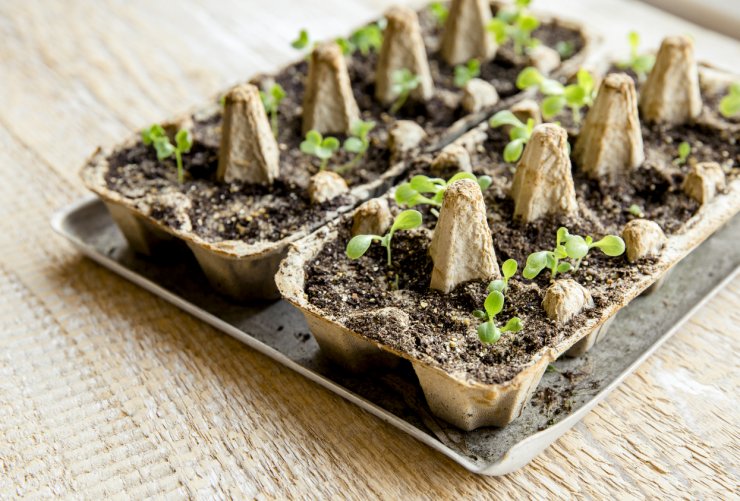
Germinating seeds in paper egg carton.
The other day, a friend of mine was working on a science project with her elementary schooler. It was the classic, but still really cool, experiment where you learn how to germinate seeds and watch them grow into little seedlings. They had a little problem, though. The seeds that they were originally trying to use would not germinate. At all.
Of course, one of the great things about science is that you can learn a lot by failing. That was little consolation to her son, however. The experiment morphed into not just how to germinate seeds, but how to speed up the process.
I have to admit, their experiment brought to mind all the times I’ve forgotten to start my seeds on time. Life gets busy, and sometimes those vegetables that I meant to start two weeks ago are still lying dormant in seed packets. What to do then?
Discover 7 top tips for growing, harvesting, and enjoying tomatoes from your home garden—when you access the FREE guide The Best Way to Grow Tomatoes, right now!
How to germinate seeds so you can still enjoy your favorite vegetable even if you forgot to start the seeds on time
There are lots of reasons for learning how to germinate seeds on the speedier side – besides forgetfulness. Short growing seasons or an especially wet spring are two reasons you might want to speed up the process a little. And some seeds take a long time to germinate. If you have some old seed packets around, it’s also a great way to test your seeds to see if they will grow.
For most vegetable seeds, you can speed up the process by soaking them in room temperature water for 8 – 10 hours. This rehydrates the seeds and softens the seed coat so it’s easier to sprout. This is similar to soaking beans before you cook them, for example. One thing to be aware of, however, is that unlike beans, you won’t be cooking your seeds, so don’t let them soak too long.
At this point, there are a few different approaches you can take. What you choose depends in part on what you’re planting, but there’s some personal preference here, too. For cooler weather crops, some people prefer to plant seeds right away and cover them with a tunnel. Other people like to lay their seeds on damp paper towels and store them in a plastic bag until they sprout.
My preference is to use paper egg cartons. They aren’t necessarily better than other containers, but since they’re biodegradable, I can plant them directly in the soil when my seedlings are ready. Basically, it saves me the work of transplanting. It’s easy, too.
Discover 7 top tips for growing, harvesting, and enjoying tomatoes from your home garden—when you access the FREE guide The Best Way to Grow Tomatoes, right now!
All you need to do is poke a few holes in the bottom of each egg cup, fill each cup with your favorite seed starting mix, and then plant one seed in each egg cup. Some seeds prefer cool temperatures, but I’ve found that for most of the vegetables I plant, setting the cartons on top of the refrigerator works well. That gives the seeds just enough warmth without overheating them. Be sure to put a towel or tray underneath the egg cartons to catch any water that does leak through those holes.
Once your seeds have turned into seedlings and the temperature outside is right, you can cut each individual egg cup and plant it directly into your garden. It’s really that easy. Now just wait a few weeks to start enjoying radishes, peas, or any of your favorite vegetables.
And in case you’re wondering, my friend and her son figured out how to germinate seeds in time for the experiment to be a success!
How do you germinate your seeds? Or do you prefer to plant them and let nature do its thing? I’d love to get your thoughts in the comments.
Discover 7 top tips for growing, harvesting, and enjoying tomatoes from your home garden—when you access the FREE guide The Best Way to Grow Tomatoes, right now!





I save all the toilet paper cardboard rolls. I make them into little pots by cutting a few slits into one end and folding and gluing them. These are ready for planting seeds. Just as the egg cartons, once the seeds are sprouted and are then seedlings, you don’t have to disturb the plants to transplant, just put the whole little pot into the soil and it’s tready to grow. This trick also helps to keep chipmunks and squirrels from digging up the seeds.
I sandpaper or use the sidewalk to gently scratchthe outside shell. I then put them in a damp paper towel in a ziplock in the refrigerator.
Goes even quicker!
Genius!
I let my seeds soak in room temp water for 9 hours, then wrapped them in damp paper towel, & slid them into a sandwich baggie, & sealed out all the air. How long should I leave the seeds in their sandwich baggies?
Keep checking them every day or so until they have sprouted. Germination time varies considerably depending on what you’re hoping to grow.